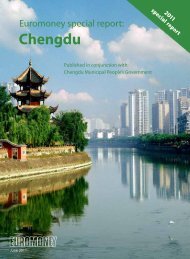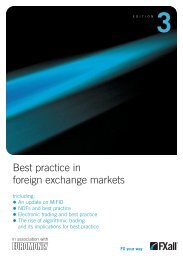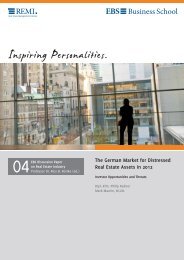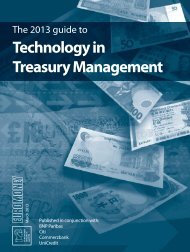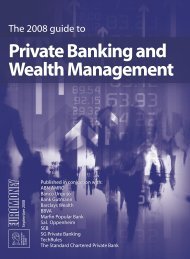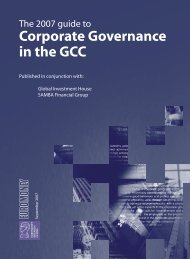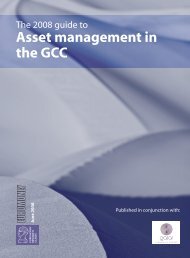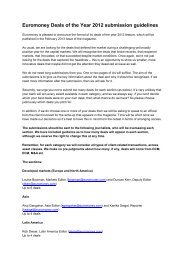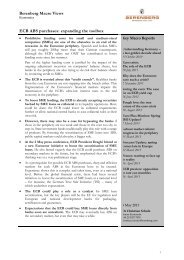Download guide (PDF) - Euromoney
Download guide (PDF) - Euromoney
Download guide (PDF) - Euromoney
Create successful ePaper yourself
Turn your PDF publications into a flip-book with our unique Google optimized e-Paper software.
The 2012 <strong>guide</strong> to<br />
GLOBAL RISK TRENDS<br />
7<br />
high-risk sovereign today, indistinguishable<br />
from Finland on a score of 91.2. Ireland,<br />
ranking 20th when the survey began (but<br />
now down to 48th), and Italy, bubbling<br />
just below the surface in 24th position<br />
(currently 41st), were also considered much<br />
safer sovereigns for global treasurers. In<br />
fact, all of the top-ranking ECR countries in<br />
1992 now have reduced scores. The world<br />
has indeed become a riskier place.<br />
Even in 1999, when the euro project reshaped<br />
Europe’s boundaries, exactly half of<br />
the top 20 safest sovereigns in the world<br />
were eagerly awaiting conversion to the<br />
single currency. With banking systems<br />
superficially secure, the distress seen<br />
today seemed a distant prospect. Eurozone<br />
participants had, after all, signed up to<br />
macroeconomic stability, dispensing with<br />
their mostly-depreciating currencies, high<br />
inflation and weak, uncompetitive growth<br />
rates, by locking in to Germany’s strong<br />
economy and pocketing the ‘insurance<br />
policy’ offered by the ECB’s pooled reserves<br />
and apparently strict membership rules.<br />
Or so it seemed. Today, only six countries<br />
out of an expanded 17-nation euro currency<br />
area are among the world’s top 20 ‘safest’.<br />
And with France slipping to 19th in ECR’s<br />
rankings this year, it may not be too long<br />
before there are just five.<br />
As the risks surrounding Europe’s debt<br />
problems mount, so the rest of the world is<br />
also becoming less safe – a worrying sign for<br />
treasury managers. Virtually all of the other<br />
main regions/economic groups have become<br />
riskier so far this year, led by the emerging<br />
powerhouses (the BRICs), Central and<br />
Eastern Europe and the Middle East. But<br />
it’s a pattern that cannot be explained by<br />
contagion alone, even if Europe’s problems<br />
have invariably led ECR’s survey contributors<br />
to reassess the risk outlook as exports and<br />
capital flows are affected. A combination<br />
of economic, political and structural factors<br />
is to blame. They range from bank stability<br />
risk, transfer risk (the risk of government<br />
non-payment/non-repatriation), currency<br />
stability risk and the risks associated with<br />
the regulatory and policy environment to<br />
political factors, concerning institutions<br />
and government stability, all of which have<br />
particular relevance to corporate treasury<br />
decision-making.<br />
More than 400 economists and country<br />
risk experts from a range of financial and<br />
other institutions take part in <strong>Euromoney</strong>’s<br />
Country Risk Survey. They evaluate the<br />
risks faced by international investors in<br />
186 markets worldwide, scoring countries<br />
across a range of political, economic and<br />
structural risk criteria. The ECR survey<br />
combines these contributor assessments<br />
on 15 of the most important risk factors<br />
with other data regarding access to capital,<br />
credit ratings and debt, to formulate an<br />
overall score out of 100 (where 100 is<br />
the least risky and zero the most). The<br />
survey has been undertaken since late<br />
1992 and is updated daily on a ‘real-time’<br />
basis, with scores collated and aggregated<br />
each quarter for comparison purposes.<br />
It can therefore provide an early warning<br />
indicator of emerging risks, distinct from<br />
the sovereign credit ratings supplied by<br />
the various ratings agencies. Further<br />
information on the survey is available from:<br />
www.euromoneycountryrisk.com.<br />
“ As the risks surrounding Europe’s<br />
debt problems mount, so the<br />
rest of the world is also becoming<br />
less safe – a worrying sign for<br />
treasury managers



